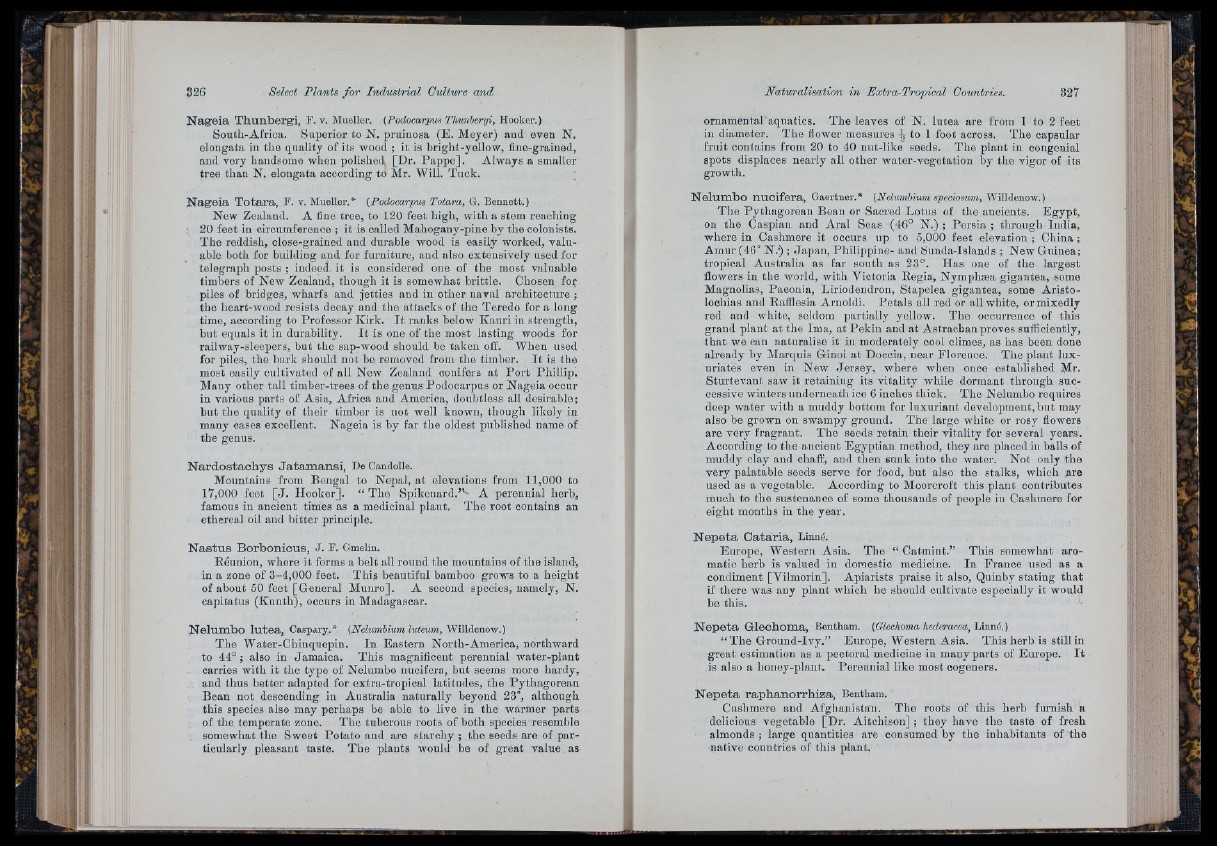
lir.
Nageia Thunbergi, P. v. Mueller. (Podocarpus Thunbergi, Hooker.)
South-Africa. Superior to N. pruinosa (E. Meyer) and even N.
elongata in the quality of its wood ; it is bright-yellow, fine-grained,
and very handsome when polished [Dr. Pappe]. Always a smaller
tree than N. elongata according to Mr. Will. Tuck. ;
Nageia Totara, P. v. Mueller.* (Podocarpus Totara, G. Bennett.)
New Zealand. A fine tree, to 120 feet high, with a stem reaching
• 20 feet in circumference ; it is called Mahogany-pine by the colonists.
The reddish, close-grained and drirable wood is easily worked, valuable
both for building and for furniture, and also extensively used for
telegraph posts ; indeed it is considered one of the most valuable
timbers of New Zealand, though it is somewhat brittle. Chosen for
piles of bridges, wharfs and jetties and in other naval architecture ;
the heart-wood resists decay and the attacks of the Teredo for a long
time, according to Professor Kirk. I t ranks below Kauri in strength,
but equals it in durability. I t is one of the most lasting woods for
railway-sleepers, but tlie sap-wood should be taken off. When used
for piles, the bark should not be removed from the timber. I t is the
most easily cultivated of all New Zealand conifers a t P o rt Phillip.
Many other tall timber-trees of the genus Podocarpus or Nageia occur
in various parts of Asia, Africa and America, doubtless all desirable;
but the quality of tlieir timber is not well known, though likely in
many cases excellent. Nageia is by far the oldest published name of
the genus.
Nardostachys Jatamansi, He Candolle.
Mountains from Bengal to Nepal, at elevations from 11,000 to
17,000 feet [ J . Hooker]. “ The Spikenard.” ' A perennial herb,
famous in ancient times as a medicinal plant. The root contains an
ethereal oil and bitter principle.
Nastus Borbonicus, J. P. Gmelin.
Reunion, where it forms a belt all round the mountains of the island,
in a zone of 3-4,000 feet. Tliis beautiful bamboo grows to a height
of about 50 feet [General Munro]. A second species, namely, N.
capitatus (Kunth), occurs in Madagascar.
Nelumbo lutea, Caspary.* (Nelumbium luteum, ViiWAexiOV/.)
The Water-Chinquepin. In Eastern North-America, northward
to 44° ; also in Jamaica. This magnificent perennial water-plant
carries with it the type of Nelumbo nucifera, but seems more hardy,
and thus better adapted for extra-tropical latitudes, the Pythagorean
Bean not descending in Australia naturally beyond 23“, although
this species also may perhaps be able to live in tlie warmer parts
of the temperate zone. The tuberous roots of both species resemble
somewhat the Sweet Potato and are starcliy ; the seeds are of particularly
pleasant taste. The plants would be of great v a lu e . as
ornamental aquatics. The leaves of N. lutea are from 1 to 2 feet
in diameter. The flower measures ^ to 1 foot across. The capsular
fruit contains from 20 to 40 nut-like seeds. The plant in congenial
spots displaces nearly all other water-vegetation by the vigor of its
growth.
Nelumbo nucifera, Gaertner.* (Nelumbium speciosum, VfiWdenow.)
The Pythagorean Bean or Sacred Lotus of the ancients. Egypt,
on the Caspian and Aral Seas (46° N.) ; Persia ; through India,
where iu Cashmere it occurs up to 5,000 feet elevation ; Cliina ;
Amur (46° N.) ; Japan, Philippine- and Sunda-Islands ; New Guinea;
tropical Australia as far south as 23°. Has one of the largest
flowers in the world, with Victoria Regia, Nymphæa gigantea, some
Magnolias, Paeouia, Liriodendron, Stapelea gigantea, some Aristo-
lochias and Rafflesia Arnoldi. Petals all red or all white, or mixedly
red and white, seldom partially yellow. The occurrence of this
grand plant a t the Ima, at Pekin aud at Astracban proves sufficiently,
th a t we can naturalise it in moderately cool climes, as has been done
already by Marquis Ginoi at Docoia, near Florence. The plant lu x uriates
even in New Jersey, where when once established Mr.
Sturtevant saw it retaining its vitality while dormant through successive
winters underneath ice 6 inches thick. The Nelumbo requires
deep water with a muddy bottom for luxuriant development, but may
also be grown on swampy ground. The large white or rosy flowers
are very fragrant. The seeds retain their vitality for several years.
According to the ancient Egyptian method, they are placed iu balls of
muddy clay and chaff, and then sunk into the water. Not only the
very palatable seeds serve for food, hut also the stalks, wliich are
used as a vegetable. According to Moorcroft this plant contributes
much to the sustenance of some thousands of people in Cashmere for
eight months in the year.
Nepeta Cataría, Linné.
Europe, Western Asia. The “ Catmint.” This somewhat aromatic
herb is valued in domestic medicine. In France used as a
condiment [Vilmorin]. Apiarists praise it also, Quinby stating th a t
if there was any plant which he should cultivate especially it would
be this.
Nepeta Gleohoma, Bentham. (Olechoma hederacea,JÁmíé.)
“ The Ground-Ivy.” Europe, Western Asia. This herb is still in
great estimation as a pectoral medicine in many parts of Europe. I t
is also a honey-plant. Perennial like most cogeners.
Nepeta raphanorrhiza, Bentham.
Cashmere and Afghanistan. The roots of this herb furnish a
delicious vegetable [Dr. Aitchison] ; they have the taste of fresh
almonds ; large quantities are consumed by the inliabitauts of the
native countries of this plant.
: ;